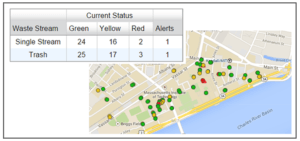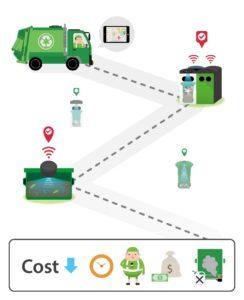Connecting Waste

Spread throughout HBS campus, BigBelly’s trash cans are a great example of how simple connected technology transforms the operating and business model of an old and basic industry – Waste Management.
The traditional waste management system involves trucks moving around a city or employees walking on sites on designated routes for collecting waste, despite whether containers are full or empty. This inefficient way of managing waste is not only time consuming but costs more and in cities with large truck fleets, adds to congestion and pollution.[1]
Smart Waste Management
Powered by a solar panel, BigBelly’s trash units are equipped with laser capacity sensors and a compactor. When the sensor detects new trash piling up, it sends a signal to the compactor which presses it down. This allows a normal unit to store as much as 8 time s the amount of trash compared to a regular same sized “stupid” unit. The unit sends out an email notification with its capacity status to a central cloud based information center.
s the amount of trash compared to a regular same sized “stupid” unit. The unit sends out an email notification with its capacity status to a central cloud based information center.
This updated status of real-time data of amounts of disposals is used to improve performance, reduce inefficiencies and manage costs. By monitoring and studying history data, waste systems managers can learn “unit’s utilization” and change location as needed. [2]
For example, an unutilized trash can in Shad would probably be moved to a popular fast filling location on Aldrich. This simple, yet genius, concept is changing the way we trash disposal systems around the world operate.[3]
Labor and Transportation costs
In the old method with regular trash cans, an employee must check all bins a few times a day, and collect trash from full units. With the connected unit system, the same employee can know which units are full before heading out on the route. Using smart algorithms considering time and distance (Uber Style), a best efficient route can be generated to further decrease costs by saving time and gas.
Philadelphia is an example of a municipal that by transitioning to smart waste management is saving an estimated $1M a year while making the city cleaner and greener.
1200 Bigbelly units are placed throw-out the streets of the city, together collecting 30 to 40 tons of trash a day. The connected network of cans allowed the city’s Street Department to reduce personnel from 33 to just 9, who now collect garbage from the cans only 5 times a week as opposed to 17 before. With a unit cost of $3800, as opposed to $100 cost for a regular trash can, it is presumed that a unit will pay back the investment within 4 years.
The projection is clear, in 10 years most of the cities and big organizations will be using some sort of smart Waste Management System. This means the labor and truck fleet of these organizations will be reduced to the minimum needed to operate.
Risks
Labor
In some organizations, the employees are protected by unions and long term contracts. How will different organizations choose to handle the decreasing need in labor force? Will the investment still pay itself back in 4 years if not able to cut costs on unutilized labor?
How will a city react to a cyber-attack on its waste system? With not enough labor and trucks is it reasonable to say municipals will be unprepared to go back to the old method? With 30-40 tons of trash thrown daily in Philadelphia, this could become a serious issue.
Maintenance
When it comes to its Waste Management solutions an organization must be very picky. There are dozens of firms competing for business with large organizations and municipals. While the basic solution is the same, the technology and maintenance required changes. Some, like BigBelly’s units, are solar powered while others aren’t. Some are built in and others are attached on top of a basic “stupid” can. If a unit still requires labor on a daily/weekly basis for maintenance it contradicts a large part of the systems value proposition.
Moving forward
The more information is gathered and shared along the operation chain the more efficient it will become. Today, although units are divided to different types of disposals – recycled paper, cans, bottles, compost and regular trash, the public is still not educated or motivated to place items in the right bins.
Soon, I believe, we will see smart cans that not only create an efficient waste management network but also separate the different kinds of waste collected automatically with a set of smart sensors. Once these systems are all in place, the information could be passed to waste facilities at the end of the operation chain so these could know real time exact amounts of materials expected to arrive via trucks. Then, these facilities could manage their own labor and energy more efficiently.
(790 words)
[1] Synapt company home page, [http://www.synapt-iot.com/waste-management.html], accessed November 2016
[2] Enovo Company home page, [https://www.enevo.com/], accessed November 2016
[3] BigBelly Company home page, [http://bigbelly.com/solutions/stations/], accessed November 2016
Images:
Image 1 – from “Smartcitiescouncil.com”, [http://smartcitiescouncil.com/article/how-smart-waste-management-solution-eliminates-wasted-effort], accessed November 2016
Image 2 – from “ecublabs.com”, [http://ecubelabs.com/], accessed November 2016
Image 3 – from link-labs.com, [https://www.link-labs.com/smart-waste-management/], accessed November 2016




I have always found these “smart” trash systems simple yet extremely effective as it covers all the requirements a municipality would want (cleaner streets and reduced operating costs). The issue I see here is getting more cities to adopt this technology and put the upfront capital investment that is required on each mayor’s term. This could significantly affect the city’s budget for a given year (provided the long-ish pay-back period) but of course governments could always phase out the installation of these smart systems throughout the city. I very much agree that the reduction in maintenance cost and after-sale-services will be a defining factor between the different waste management systems that are currently available in the market. What I believe would be an eye opening factor to add is the monetization potential that governments could achieve through the efficient waste management supply chain as well as the handling of the waste for other uses.
Wow! I had no idea these systems were so sophisticated – I was under the assumption that they were simply operating as compactors, I didn’t realize that the data could be used to improve the efficiency of the pick-up effort as well. Is it still the responsibility of the municipality or organization to empty the bins? I wonder if they could introduce another revenue opportunity by assuming that responsibility as a subscription based service – that would be problematic for government employees/unions, but it would likely be more cost-effective for the customer in the longer-term. I also wonder how smart the sensors in the cans are – can they identify any information about the waste itself? That would be super interesting data to have.